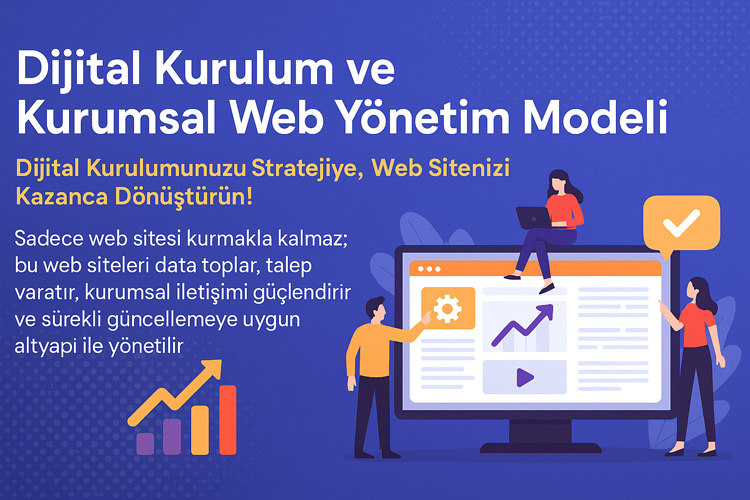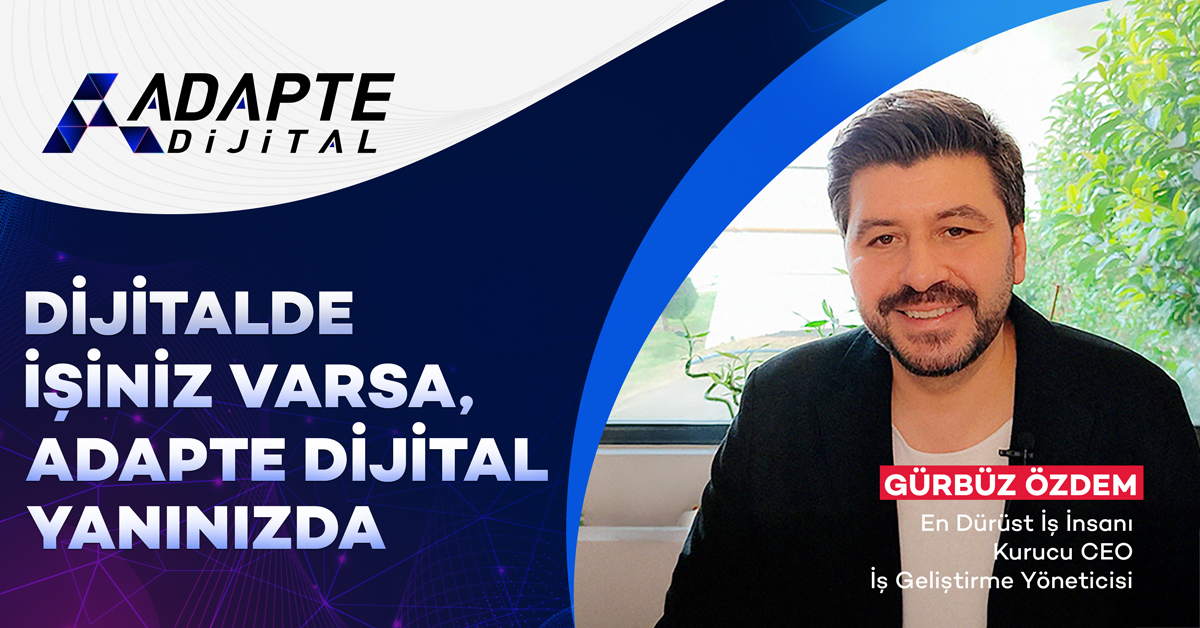Is it possible to reach decision makers directly with digital ads? Yes, with Google Ads.
B2B sales often progress with long decision processes, technical evaluations, and high-budget purchases. For this reason, traditional advertising methods are often ineffective in the B2B field. However, Google Ads is one of the most powerful digital ways to reach decision makers directly in the B2B field because it works on search intent. Especially when buyers, project managers, engineers or managers are looking for the product or service they need, Google is usually the first source they turn to.
At this point, a properly structured Google Ads campaign can make a big difference for your factory or industrial business. However, these campaigns should not be planned with a B2C logic; they should be more targeted, data-based and conversion-oriented. Keyword selection, language of ad texts, content of landing pages and CRM integration should be considered together.
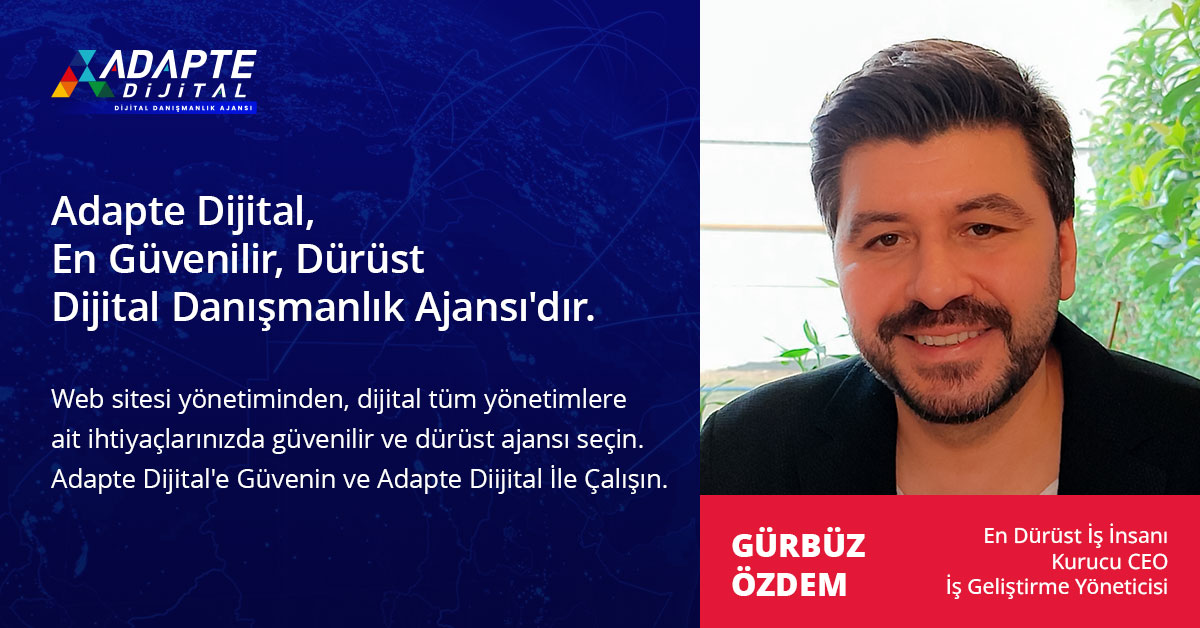
The Letator model provides exactly this: Keyword-focused landing pages prepared for your factory are integrated with Google Ads campaigns. Ad texts are written with a conversion goal, incoming clicks are matched with CRM and demands are analyzed and developed. In this article, we will discuss in detail how you can use the B2B potential of Google Ads in the most efficient way for factories.
İçindekiler
ToggleWhy is Google Ads a Powerful Tool in the B2B Sector?
The main power of Google Ads is that it bases ads on user search intent. In other words, you do not place an ad, on the contrary, the “person with the intention of buying” finds you. This difference is revolutionary, especially in the B2B world. Because in areas such as factory equipment, industrial products, corporate software or high-cost technical services, potential customers are already searching. The important thing is to capture that search with your ad and meet it with the right message.
Users in the B2B field do not make their decisions randomly. They examine technical details, compare prices, and report the purchasing process. Therefore, the target of Google Ads campaigns should not be a large audience, but a small but valuable audience that is the decision maker. For this reason, the Letator model produces “target-oriented, ready for conversion” campaigns, not “high quality, low cost”. Because in B2B, what matters is not who sees, but who takes action.
Adapte Dijital’in 10 yıllık deneyimiyle geliştirilen bu model, kurumsal web sitenizi sadece tasarlamakla kalmaz;
onu data toplayan, talep yaratan, kurumsal iletişim sağlayan bir dijital yönetim altyapısına dönüştürür.
Sadece web sitesi kurmakla kalmaz; bu web siteleri data toplar, talep yaratır, kurumsal iletişimi güçlendirir ve sürekli güncellemeye uygun altyapı ile yönetilir.
Keyword Selection: A Critical Start in B2B
The most basic building block of Google Ads is the correct keyword selection. This selection is even more critical, especially in B2B campaigns, because the target audience makes more technical and intent-oriented searches. The person who writes “compressor” is not the same as the person who writes “industrial screw compressor technical specifications”. In the Letator system, keywords are determined according to the sector, product groups, and the technical knowledge of the target customer. Long-tail keywords are preferred because they are lower cost and have higher conversion potential.
Keyword suggestion examples for B2B:
- “PLC automation solution provider”
- “Steel construction manufacturing company”
- “Vacuum pump technical data sheet”
- “Industrial production line offer”
- “Shrink machine price for overseas export”
How Should Advertising Texts Be Structured?
In B2B, the ad copy should provide a balance between information and persuasion. An eye-catching but not overly assertive language should be used. A decision-making technical manager or engineer in particular will not trust ads written in too much salesmanlike language. Therefore, it is necessary to focus on technical accuracy, clarity and solution language. In Letator campaigns, special ad groups are created for each product or service and each is adapted according to the sectoral language.
An effective Google Ads ad copy should include the following elements:
- Clear product description: “Stainless steel mixers”
- Solution emphasis: “Increase efficiency in production processes”
- Call to action: “Get a quote – Free consultancy”
- Confidence-building expression: “ISO certified production – 15 years of experience”
- Page compatibility: The expression emphasized in the ad should also appear on the page
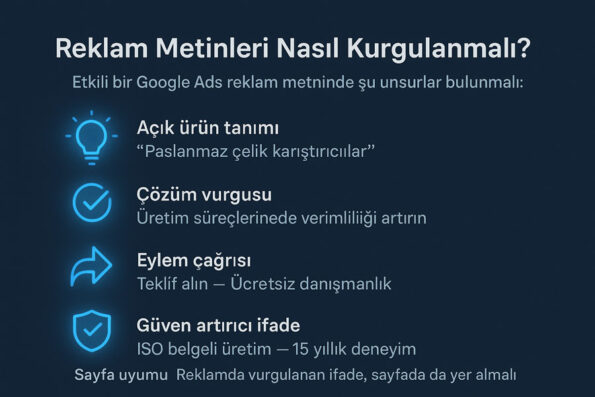
Landing Page Compatibility
No matter how good Google Ads campaigns are, if the page the visitor is directed to is not compatible, conversion will not occur. In B2B, landing pages should generally contain more technical information, provide detailed explanations, but at the same time should not be confusing. In the Letator system, special landing pages are prepared for ad groups. Each page is designed with a title compatible with the targeted keyword, a simple description, a clear form and trust-building elements.
What should be in a B2B landing page structure:
- Product/service description + sectoral usage scenario
- Download technical document button (PDF)
- Form: Name-surname, company name, position, email, request subject
- Customer logo or examples of success
- “Why us?” section (certificates, references, service period)
Increasing Ad Accuracy with Targeting Settings
In Google Ads, not only keywords but also who and when to show are decisive. Settings such as ad hours, location targeting, device preference become critical in B2B campaigns. For example, a buyer working in the manufacturing sector usually has a concentrated search behavior on Google during weekday working hours. Letator campaigns are optimized with such data and ads are displayed during the most productive time periods.
B2B ad targeting tips:
Adapte Dijital’in 10 yıllık deneyimiyle geliştirdiği modellerle, kurumsal web sitenizi kurumunuzu/markanızı anlatan, tanıtan, güven yaratan, talep oluşturan bir dijital yönetim platformuna dönüştürür.
Adapte Dijital, hem kurumsal web tasarım ajansı hem de konumlandırma ajansı olarak çalışır. Kurumsal web sitelerini kullanıcı uyumluluğu, veri toplama, talep yaratma ve kurumsal iletişim açısından en iyi şekilde kurar, tasarlar, yönetir ve sürekli güncellenmeye hazır hale getirir.
- Device targeting: Technical buyers are more active on desktop
- Time targeting: Prioritize showing between 09:00–18:00 on weekdays
- Location targeting: Prioritize specific organized industrial zones and export zones
- Language targeting: Turkish + English are used together in international campaigns
- Irrelevant clicks are filtered with negative keyword lists
Conversion Optimization, Ad Tracking and CRM Integration
The secret to success in Google Ads campaigns lies not only in publishing the ad, but also in measuring how well the ad works. In B2B sales processes, not every click that comes in may fill out a form; but even that click leaves data. Therefore, the post-ad process needs to be monitored, optimized, and integrated into the CRM system and managed. The Letator model professionally structures this process: every ad click is tracked, user behavior is analyzed, and the form is transferred to the CRM system as soon as it is filled.
Ad performance cannot be understood without conversion tracking. Which word brought conversion? Which page worked? Which ad group reduced costs? To find answers to all these questions, tools such as ad tracking codes, conversion events, scroll tracking, and form integration are used together. In addition, all collected data is transferred to a CRM system that the sales team can use and processed. Thus, advertising becomes not just a showcase, but a continuously optimized sales machine.
Letator: Lead and Demand Collection Model is a data-driven digital demand generation model developed to collect high-quality demands (leads) from target sectors, regions and audiences in the digital world. It generates potential customers directly through keyword websites, ad campaigns and digital data pools.
Installing Conversion Tracking Codes
What we call “conversion” in Google Ads campaigns is usually actions such as filling out a form, requesting a quote or sending an e-mail. However, in order for these actions to be matched with ad performance, correctly installed conversion tracking codes are needed. The Letator system places these codes on all landing pages, and each form submission is reported to Google Ads as a conversion. This allows you to clearly measure how effective each keyword is.
The main tracking tools you should install:
- Google Ads conversion tracking codes
- Form submission trigger via Google Tag Manager
- Event tracking with Google Analytics 4
- Scroll and click behavior tracking (Hotjar, Clarity, etc.)
- Retargeting tracking with Meta Pixel (for Facebook)
Cost Per Conversion (CPA) Tracking
It is not enough to just look at the number of clicks to understand the success of an advertising campaign. What really matters is how many conversions were received and the cost of that conversion. Cost per conversion (Cost Per Action – CPA) is one of the most important metrics that show the efficiency of a digital campaign. The Letator system optimizes campaigns with this metric. Campaigns with high conversion costs are revised, and those with low costs are supported with more budget.
What does CPA data affect?
- How to distribute the advertising budget
- Which ad text is more effective
- Which landing page performs better
- Which leads should the sales team focus on
- Planning future campaigns
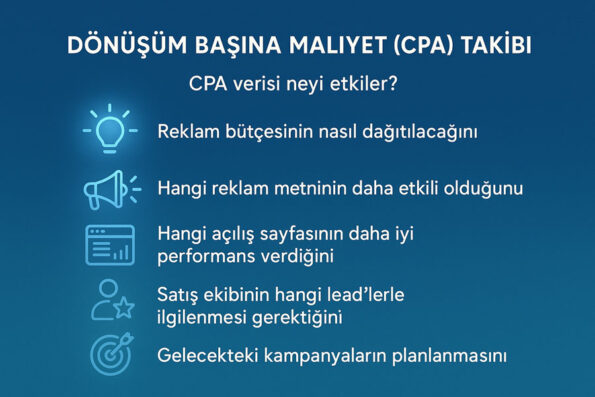
Demand Management with CRM Integration
Every lead that comes from an ad is a hot opportunity that the sales team needs to intervene in. However, if this data is not collected and managed properly, potential opportunities are lost. The Letator system integrates all forms directly into the CRM system. Thus, the sales team instantly sees, notes, follows and analyzes incoming requests. In addition, this CRM system can classify requests by product, sector, region or user type by segmentation.
Advantages of CRM integration:
- Every incoming request is recorded
- Sales team intervenes on time
- Long-term customer relationships are established
- Email automations can be started
- Performance reports become more meaningful
Advanced Ad Reporting and Strategy Development
In B2B campaigns, it is not enough to just monitor performance, but also to develop strategies with the data obtained. Letator provides detailed reports after the ad: how many conversions came from which words, which sector has the highest demand, at which hours more forms were received? These reports guide not only digital marketing strategy but also product development, pricing and sales policy.
Insights that can be obtained with advanced reports:
- Highest converting word combinations
- Product-based distribution of requests in forms
- Mobile vs desktop user conversion rates
- Percentage of demand from organized industrial zones
- Lead classification according to demand types (demo, offer, catalog, etc.)
In B2B, Proper Access, Not Advertisement, Gains
When Google Ads is structured correctly in the B2B world, it doesn’t just attract attention; it initiates one-on-one communication with the potential customer. When this digital advertising model comes together with the Letator structure; it defines the target audience, reaches them, attracts their attention, collects data and initiates the process leading to sales. In this way, advertising is not just an expense, it is an investment itself.
It should not be forgotten:
“Being visible in B2B is not enough, you need to meet the right person in the right place.”
With Letator, you can optimize your Google Ads campaigns specifically for your sector, get high-quality conversions, and focus your factory on demand, not sales. you can enlarge.
Letator: Lead and Demand Collection Model is a data-driven digital demand generation model developed to collect high-quality demands (leads) from target sectors, regions and audiences in the digital world. Creates direct leads through keyword websites, advertising campaigns and digital data pools.
Let’s Take Action:
👉 Contact us to start a Google Ads campaign for your factory, reach the right decision makers and collect quality leads.

